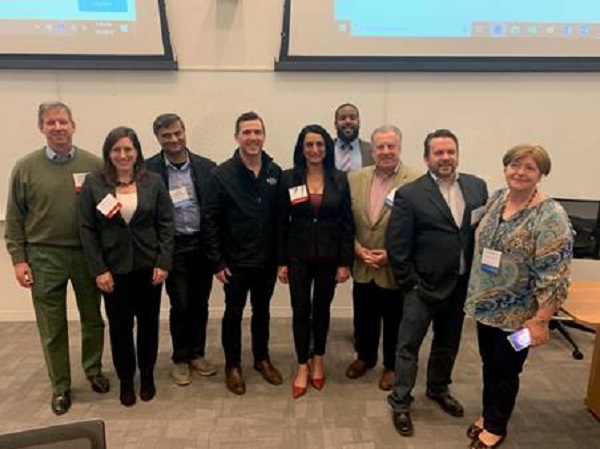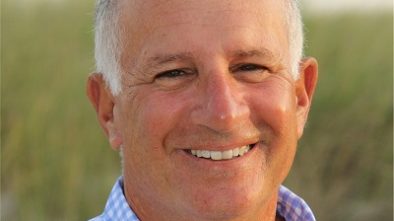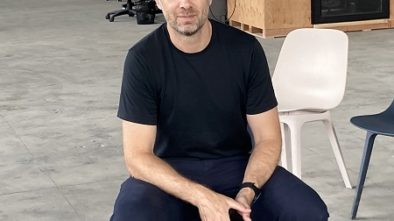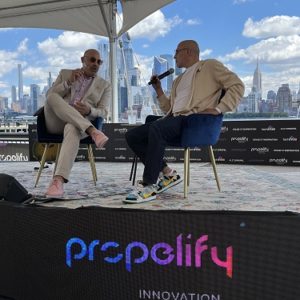New Jersey startup SiLAS Wins Audience Choice and Investor Panel Awards at February BullPen
[The next TechLaunch BullPen will take place on April 24 at Stevens Institute of Technology, in Hoboken]
Leaders of some of the most promising, investible startups in New Jersey can be found pitching at TechLaunch BullPen events, where audience members can ask questions of startup founders and an investor panel will provide critical advice.
In February, TechLaunch held its BullPen event at Rutgers University, in conjunction with the Scarlet Startups meetup group. Typically, three startups pitch at these events, and a fourth, a student-led team, also has the chance to impress the audience and the panel of investors.
The panel selects a winner from the three professional startups, and the founder of the winning company receives $20,000 in services from TechLaunch sponsors and supporters. The audience also votes on its favorite. This time, SiLAS solutions, profiled below along with the other teams, won both accolades.
SiLAS Solutions (Fair Haven)
Christopher Dudick, founder and CEO, gave the winning pitch for SiLAS, a browser-based software package that helps students learn social skills by practicing them using avatars. Some 12 years ago, Dudick founded a company teaching animation, music production and video game design, for which he won an EMMY award. He later named SiLAS “after one of the special education students that I worked with.”
Explaining the problem that SiLAS addresses, Dudick noted that 80 percent of people with social communication disorders are unemployed after they graduate. “Those are people who have autism, psychiatric disorders and developmental delays. They are physically capable of working, but have a social disorder that’s stopping them from working.”
He added that autism costs the federal government $260 billion a year, $200 billion of it spent on adult services alone. “That tells us that we are failing at education, and that we have to provide for these individuals for the rest of their lives. We know we can solve this by early diagnosis and intervention.”
One useful intervention is social skills training. “You teach them how to make eye contact, how to make an introduction, how to avoid conflict.” Students need to be coached on how to talk to a boss or a customer, but the social skills curriculum hasn’t changed in 35 years, Dudek said. And most solutions are passive, “not engaging for today’s 21st-century learners.”
SiLAS works like this: Practitioners ― social workers, speech pathologists or other specialists ― teach their students what they need to know. They then work with the students to write a script. Next, they go to a computer and have the students select the avatars they want to be, as well as the virtual environment they want to be in. The students can then simulate the scripted conversation in a “low-risk virtual environment that allows them to practice as many times and in as many different possible scenarios as they want.” And it’s fun and engaging for them. “When they move the character, it moves; when they speak, the character speaks.”
After the students are done, they are able to review the animation with their teachers for feedback. There are rubrics within the software so that sessions can be scored by the teachers. And the software provides immediate analytics for school districts to show how students are progressing. The results and animations can be shared with the students’ parents or others.
Dudick and his team conducted studies with Princeton and Kean universities, and used those studies to get a National Science Foundation grant. “We received $225,000 from the federal government to develop SiLAS. It’s patent pending,” he noted.
After his pitch, an audience member asked Dudick about the inclusion of kids from impoverished areas. Dudick said that a lot of schools in these areas have money for special education. And he added that there are other ways to help, for example, by working with nonprofits specializing in autism.
Panelist Cecily Kovatch, founder of Fueled for Growth and entrepreneur-in-residence at the Stevens Venture Center, said that she wasn’t clear about the training of the teachers: how it happens and how much it costs. Dudick said that they were starting a teacher network in which teachers can say how they are using the program, what they are doing well and what they need help with. Also, the startup has begun putting together metrics on how much the students have improved, if they are getting into fewer fights and if they are getting jobs.
Scanifly (Hightstown)
Jason Steinberg presented for Scanifly, a B2B drone-based Software as a Service for solar-energy system installers. “We are automating the development and maintenance of solar projects,” said Steinberg, who is cofounder and COO. He noted that solar energy has had massive growth, but people still say that “solar is too expensive.” The reason, he said, is the non-hardware soft costs, including the costs of labor, engineering, permits and maintenance. Big problem areas include inaccuracies in surveys, which can lead to changes in orders, and safety issues, which can lead to liabilities. “The root of this problem,” he said, is that “solar still requires a ton of inefficient processes.”
Scanifly’s software uses drone imagery to make 3D models. The software is hardware agnostic. Also, drones are inexpensive, at less than $1,500 each. Scanifly just sells the enterprise software. It’s up to the customers to use their drones (along with the software), but the company provides training in drone operation. “What matters is what you do with the drone imagery, and that’s all about software,” Steinberg told the audience.
The software traces the roof and machine learning designs the system, with “no more guess work,” he said. Then the software automatically programs a drone flight. The drone is taken to the site, where it automatically takes pictures. Using the drone images, the software will “auto-correct the preliminary design and create an optimal solar project.”
Scanifly says that the software generates more sales for the installers because their customers can visualize their projects in 3D, and that it reduces the surveying and design time by up to 90 percent. The company also offers shading analysis of any spot on the site, so as to be more precise. Also, “It reduces insurance costs by about $1,000 per worker based on keeping guys off the roof until construction,” Steinberg noted.
In his response to a question from the audience about how the software helps installers close sales, Steinberg explained that, for example, if neighbors object to having a solar-panel project within their sightline, the software will provide alternative ways to proceed with the construction, so they don’t have to deal with a panel-construction project blocking their views.
Panelist Cristian Ossa, an angel investor who is now a partner at Wolf Ossa Law (Metuchen) suggested that Scanifly make the return on investment for the installer clearer in its presentation. He also mentioned that there are only 3,500 solar installers in the United States, and suggested that the company go after the top ones. Other panelists said that the company needed to think more about its pricing model.
OnGo Energy Spray (Red Bank)
Founder and CEO Ashu Jain and Chief Digital Officer Jessica Prieto presented OnGo Energy, an energy supplement spray. Approximately one in six Americans consumes energy drinks, and it’s a $15 billion business, Prieto noted. But the market is overwhelmed by products with a high sugar content, and “you can’t forget about those bathroom breaks associated with energy drinks.” By contrast, the OnGo Spray contains natural caffeine and is sugar free, according to Jain.
Prieto said that, because of its small size, OnGo won’t compete for shelf space with energy drinks, but it offers greater value, convenience and safety than energy drinks do. She noted that OnGo Spray can be sold via e-commerce, and that subscription-based sales models will maximize the lifetime value of the product. She also told the audience that OnGo’s formula is 150 times more concentrated than the formulas for energy drinks, and that oral sprays are absorbed faster into the body.
Jain mentioned that there is a growing market for products that are organic, natural and sugar-free ― a segment that OnGo clearly fits into. “Our goal is to reach $70 million by year five. … We just launched at the end of last year and started testing our distribution channels.”
Audience members were concerned about the safety of the supplement, given the number of overdoses attributed to energy drinks. Jain responded that none of the drinks on the market come with any kind of advice to limit their use, but OnGo has a brochure and educational material about what to take, how to take it and what to mix it with. He noted that the potency is in the concentration, and that OnGo’s serving size is 75 milligrams, smaller than those of many competitors, such as 5-hour ENERGY. Overdosing is possible, but it often happens when these drinks or supplements are combined with coffee or drugs.
Panelist Pavita Howe, who manages the TechAdvance Fund at Rutgers, noted that her senior research project had been on the effects of caffeine on the body. She suggested that the founders address the effects of caffeine when pitching. She also recommended that they offer some kind of meter or safety latch on the device to ensure that a child couldn’t get to it and keep on spraying, as it does look like fun.
Aersys (Edison)
The Rutgers student team, called “Aersys,” presented its idea for an artificial-intelligence-based pod system to support last-mile drone deliveries. The team reps said that they were focusing on two markets: food delivery and parcel delivery. “Customers these days expect low-cost, flexible and fast deliveries,” they said. Delivering via regular vehicles isn’t fast and it isn’t inexpensive.
Drone deliveries are a good alternative, but they’re limited because they can’t go very far, said the team. Companies will need to build their own infrastructure networks. If they build those networks themselves, however, they will face the costs associated with building and maintenance. There are other problems, too: A new type of drone could end up making their infrastructure obsolete. If several companies compete for the same area, they will cause clutter and frustrate local residents. And the incentives the companies would have to offer to stand out from the crowd would be too expensive.
The team’s solution: “We solve all this by building a single network of universally compatible, scalable and automated micro-fulfillment centers that will help drive the adoption of drones.” The centers would be modular and easily upgradable.
An audience member noted that Aersys seemed like a high-risk startup, but the founders responded that the barrier to entry is very high for creating a platform like theirs, and they said that they were developing some very advanced robotic technologies.
Panelist Stephen Socolof, managing partner at Tech Council Ventures (New Brunswick), recommended that the team decide whether they want to be a technology developer or infrastructure provider. “Those are two different propositions, and I think the former would be easier for you to deliver on,” he said.




